Episodes
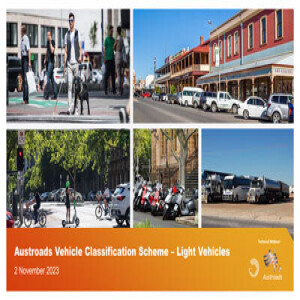
Thursday Nov 02, 2023
Austroads Vehicle Classification Scheme – Light Vehicles
Thursday Nov 02, 2023
Thursday Nov 02, 2023
Austroads has developed an extended vehicle classification scheme (EVCS) to enable improved understanding and monitoring of the evolving vehicle mix on Australian and New Zealand roads in traffic and transport surveys. This builds upon the existing 1994 vehicle classification scheme.
The EVCS provides greater granularity for each of the existing 12 classes of vehicles and adds a new class for active transport to address the need to count a variety of active transport users such as pedestrians, skateboards and e-scooters.
The EVCS will allow transport agencies to better manage transport demand within and between modes, survey active transport and understand how demands integrate with other modes.
The scheme will help identify changes in transport operational performance and optimise plans for effective access management and asset maintenance.
This webinar, presented by Drew Gaynor and David Johnston, is the second session in a three-webinar series, and it focuses on the changes to light vehicles. The first webinar covered heavy vehicles and the third session will provide information on measuring active transport.
This webinar discusses:
- level 3 classes 1 and 2
- the greater granularity in level 4 subclasses
- thresholds between classes 2 and 3
- the use of alternative counting technologies.
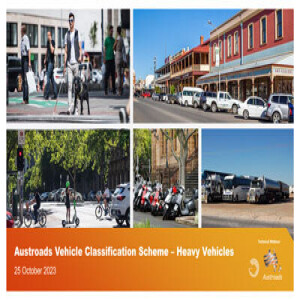
Wednesday Oct 25, 2023
Austroads Vehicle Classification Scheme – Heavy Vehicles
Wednesday Oct 25, 2023
Wednesday Oct 25, 2023
Austroads has developed an extended vehicle classification scheme (EVCS) to enable improved understanding and monitoring of the evolving vehicle mix on Australian and New Zealand roads in traffic and transport surveys. This builds upon the existing 1994 vehicle classification scheme.
The EVCS provides greater granularity for each of the existing 12 classes of vehicles and adds a new class for active transport to address the need to count a variety of active transport users such as pedestrians, skateboards and e-scooters.
The EVCS will allow transport agencies to better manage transport demand within and between modes, survey active transport and understand how demands integrate with other modes.
The scheme will help identify changes in transport operational performance and optimise plans for effective access management and asset maintenance.
This webinar, presented by Drew Gaynor and David Johnston, is the first session in a three-webinar series, and it focuses on the changes to heavy vehicles. The second webinar will cover light vehicles and the third session will provide information on measuring active transport.
This webinar discusses:
- level 3 classes 3 to 12
- the greater granularity in level 4 subclasses
- better description of axle groupings
- the creation of a new class 19 for heavy vehicles that do not fit readily into the prescribed classifications
- backward compatibility with existing heavy vehicles counting
- further validation of some sections.

Thursday Feb 16, 2023
Zebras and Wombats: Factchecking “False Sense of Security”
Thursday Feb 16, 2023
Thursday Feb 16, 2023
Decisions on how transport agencies provide for people walking to safely cross the roads has been greatly influenced by historical research, that has in the past failed to examine the infrastructure design and lacked behavioural data.
This webinar, presented by Mark McDonald, Principal Technologist (Bicycles, Pedestrians and Motorcycles) at the Queensland Department of Transport and Main Roads, looks at the different types of pedestrian crossing controls, behavioural responses of both drivers and people crossing and analyse the road safety implications. The presentation goes through the crash characteristics involved, including control of crash forces, analysis of crash braking patterns, the impact of uniform pavement marking on reaction times, speed and yield rates and crash reduction factors.
The webinar gives a review of safe system and evidence-based research relating to unsignalised crossings for people walking or riding bikes. It answers the questions: Who are we relying on? What is the safety evidence? Is “false sense of security” supported by evidence?
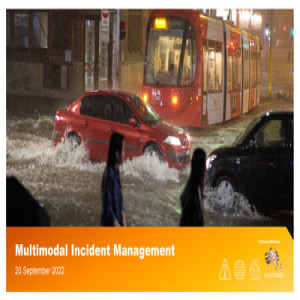
Tuesday Sep 20, 2022
Multimodal Incident Management
Tuesday Sep 20, 2022
Tuesday Sep 20, 2022
Road agencies increasingly recognise the value of coordination and cooperation with public transport operators in responding to road and transport incidents, as it helps support a more holistic and integrated multimodal approach to minimising traveller disruption.
Austroads has developed guidance for road-focused agencies to improve their capabilities in the management and resolution of an unplanned incident that negatively impacts, or has the potential to impact, the normal operation of more than one transport mode.
This webinar, presented by David Yee and Andrew Somers, provides an overview of the multimodal incident management (MMIM) research findings and agency guidance. The guidance examines worldwide MMIM methods and practices, and identifies key themes and principles for agencies to consider in planning and developing their MMIM capabilities. These themes include vision and strategy for MMIM, coordination and cooperation, integrated operations centres, leverage existing practices, integrated traveller information, traveller demand management and network load balancing, alternative transport services, multimodal data exchange, MMIM tools, and intelligence and decision making.
The webinar also offers advice on how to improve MMIM capabilities using a MMIM Capability Framework that consists of three components:
- a set of MMIM capabilities
- a MMIM Capability Maturity Model
- guidance
The capabilities are the foundational abilities that should be developed. The Capability Maturity Model is a maturity scale for MMIM capabilities that can be used by agencies to set future targets and to measure against. The guidance advises how to use the Capability Maturity Model to plan and improve MMIM capabilities.
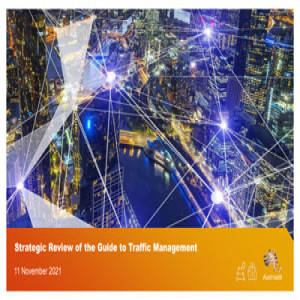
Thursday Nov 11, 2021
Strategic Review of the Guide to Traffic Management
Thursday Nov 11, 2021
Thursday Nov 11, 2021
Austroads Guide to Traffic Management (AGTM) has been a valuable resource for industry, particularly amongst traffic engineering and operations cohorts. The transport context is evolving rapidly, and a strategic review identified that a new approach is needed to keep pace with industry expectations and the strategic objectives of Austroads and its members.
The new Austroads Guide to Transport Operations and Management (AGTOM) is planned to feature a new format as well as updated content.
This webinar, presented by Richard Delplace, Andrew Somers, Craig Moran, Andrew Wall and Simon Latham, covers:
- The key findings of the review of AGTM.
- Insights from leaders within transport agencies on the challenges the new AGTOM needs to help users to navigate.
- The objectives, rationale and overview of the new AGTOM.
- Austroads’ plans to transition from the AGTM to the AGTOM.

Thursday Jul 22, 2021
Austroads Project Pipeline 2021-22
Thursday Jul 22, 2021
Thursday Jul 22, 2021
This webinar provides an overview of Austroads’ projects 2021-22 and what is required to work with Austroads.
The session is beneficial to consultants who may be interested in tendering for Austroads projects.
The projects discussed focus on data collection and management, digital engineering, tunnel design and componentry, bridge assessment, pavement technology, road design, road safety audits, driver licensing, environment reporting, and vehicle and infrastructure connectivity.
The webinar is presented by Paul Davies, Austroads Acting General Manager Operations, and program managers:
- Ross Guppy, Program Manager Transport Infrastructure
- Michael Nieuwesteeg, Program Manager Road Safety and Design
- Richard Delplace, Program Manager Transport Network Operations
- Vibeke Matthews, Acting Program Manager Future Vehicles and Technology, and Environment and Sustainability Program.
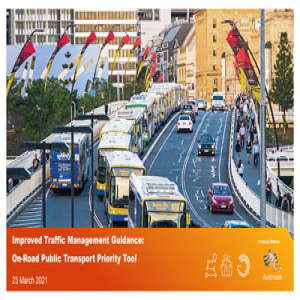
Tuesday Mar 23, 2021
Improved Traffic Management Guidance: On-Road Public Transport Priority Tool
Tuesday Mar 23, 2021
Tuesday Mar 23, 2021
On-road public transport (ORPT) priority treatments improve public transport’s level of service increasing reliability and travel time benefits for users.
Austroads has developed a practical process (referred to as a ‘tool’) to guide practitioners through the selection of the appropriate ORPT priority treatments for any road scenario. The tool is documented in the 2020 Austroads report AP-R645-20 On-Road Public Transport Priority Tool.
This webinar, presented by David Green and Graham McCabe, provides an overview of the tool explaining how it was developed and how practitioners may use the tool in their day-to-day work.
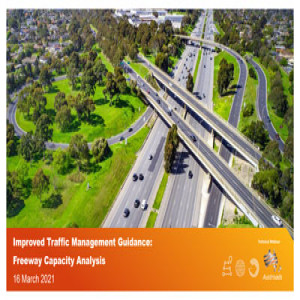
Tuesday Mar 16, 2021
Improved Traffic Management Guidance: Freeway Capacity Analysis
Tuesday Mar 16, 2021
Tuesday Mar 16, 2021
Austroads’ report Improved Traffic Management Guidance: Freeway Capacity Analysis reviews the latest research and practices in freeway capacity analysis and makes recommendations for updating Austroads FCA guidance.
This webinar with Paul Bennett and Graham McCabe presents the research and findings outlined in the report, including the consultations with practitioners from across Australia and New Zealand, the comparative study of different capacity analysis methodologies and the recommendations made for updating Austroads FCA guidance.
The presentation slides can be downloaded from the supporting documents tab after logging in.
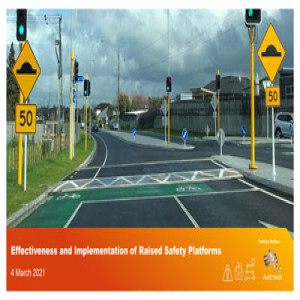
Thursday Mar 04, 2021
Effectiveness and Implementation of Raised Safety Platforms
Thursday Mar 04, 2021
Thursday Mar 04, 2021
Raised Safety Platforms (RSPs) are a vertical deflection device increasingly used to reduce the maximum comfortable operating speed for vehicles to Safe System collision speeds, particularly at intersections. While the use of vertical deflection devices has typically been limited to lower speed environments, there is increasing interest in the use of RSPs in higher speed environments and for other locations where pedestrians and cyclists would typically be injured.
The purpose of Austroads’ research report ‘Effectiveness and Implementation of Raised Safety Platforms’ was to provide clarity around the design and operation of RSPs and deepen the understanding of leading international practice across a range of applications and performance dimensions. The research included a review of literature, sample investigations and edits to relevant Austroads guides. The literature has shown that, outside of the Netherlands, where RSPs have been used extensively, a ‘community of practice’ is developing in Australia and New Zealand, with the majority of applications at signalised intersections above 50 km/h to date being in Victoria. There is evidence that RSPs are a promising road safety countermeasure.
In this webinar Fabian Marsh, Hamish Mackie and Rebekah Thorne outline the research approach and the key findings from the information review and sample investigations that have implications for future practice.
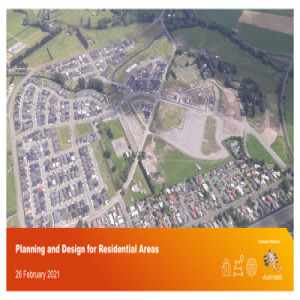
Friday Feb 26, 2021
Pedestrian Planning and Design for Residential Areas
Friday Feb 26, 2021
Friday Feb 26, 2021
This webinar, presented by Ann-Marie Head and Jeanette Ward, focuses on the planning and design considerations for walkable residential neighbourhoods, both new and existing, and where to find that guidance in Austroads’ guides.
The webinar covers the following key topics:
- what data to collect
- planning/network considerations
- design considerations
- examples of applying walkable characteristics
- best practice examples.
This is a final session in the series of webinars held by Austroads to step practitioners through the updated pedestrian planning and design information.
Austroads’ review of the pedestrian planning and design guidance in the Guide to Traffic Management (AGTM) and Guide to Road Design (AGRD) identified a total of 120 planning and design gaps. Recommended changes to the AGTM were published in April 2020 followed by a series of exceptionally popular webinars.
Recommended changes to the AGRD have been reviewed and approved by the Road Design Task Force and will find their way into the AGRD as part of its update and restructure planned by the Road Safety & Design program in FY20-21.

